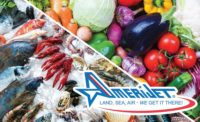The pharmaceutical cold chain and temperature-controlled shipping for the food industry are often thought of as two separate industries. However, with both industries growing, there is plenty to be learned from each other.
The life science cold chain, which deals with pharmaceuticals, clinical trials and other healthcare supplies, demands the mastery of precise storing of life-saving materials in temperature-controlled packaging. Similarly, temperature control is a critical food safety element that can help prevent foodborne diseases.
Here are three insights the cold food industry can learn from the pharmaceutical cold chain:
Prevent temperature excursions
Preventing temperature excursions is one of the most common objectives customers look for in thermal protection shipper packaging in the pharmaceutical industry. In fact, it impacts all other considerations because when it comes to shipping temperature-sensitive pharmaceuticals and clinical trial samples, temperature excursions mean the difference between success and failure, profit and loss. Although payload values and quantities may differ, the same holds true for food shipments.
When evaluating possible sources of temperature excursions, it’s important to consider the shipping route, logistics provider and packaging solution in place. Issues with any one of these cold chain components could result in product loss.
Comply with regulatory requirements
Strict regulatory requirements are imposed on both the pharmaceutical cold chain and the life science cold chain in general. In order to ensure successful cold chain lanes, manufacturers and others in the medical and pharmaceutical industry must ensure that shippers are compliant with global industry standards and recommendations such as the U.S. Centers for Disease Control and Prevention, The Parenteral Drug Association (PDA), The World Health Organization (WHO), The International Air Transport Association (IATA) and The International Safe Transit Association (ISTA), as well as EU’s strict GDP quality assurance and health and safety standards.
Manufacturers of temperature-sensitive packaging can assist customers in meeting these strict standards by providing a range of thermal tests and qualification processes to ensure packing solutions meet regulatory requirements.
Although food shipments do not have to comply with the same regulatory requirements, temperature control is a critical food safety consideration by the U.S. Food and Drug Administration (FDA). Since January 2013, the FDA has proposed seven foundational rules to implement the Food Safety Modernization Act (FSMA), including “sanitary transportation,” which among other requirements, demands that those who transport food with a need for temperature control to ensure the maintenance of transportation cold chain during operations.
With the new rules being finalized in 2016, many expect maintaining quality in the cold supply chain to come under increasing scrutiny. Looking to the highly regulated pharmaceutical cold chain provides those looking to ship food an example of how to operate within FSMA regulations.
Decrease overall costs
Both the food industry and pharmaceutical industry can benefit from decreasing overall costs. Evaluating current cold chain practices is one way to monitor a company’s efficiency. Shippers with less weight and greater volumetric payload efficiency can offer the financial advantages of lower transport costs, a result of less shipping weight.
Reusable cold chain packaging solutions can also help reduce the cost per use. These reusable solutions are reconditioned to meet health and safety standards, equal to or greater than those requirements put in place for the food industry.
The nuances of pharmaceutical and food industry cold chains differ slightly, but like the life science industry, the food industry can also address prevention of temperature excursions, regulatory compliance and an overall cost evaluation, which can only help the food industry go further. Be sure these considerations are a part of your planning process in 2017.



